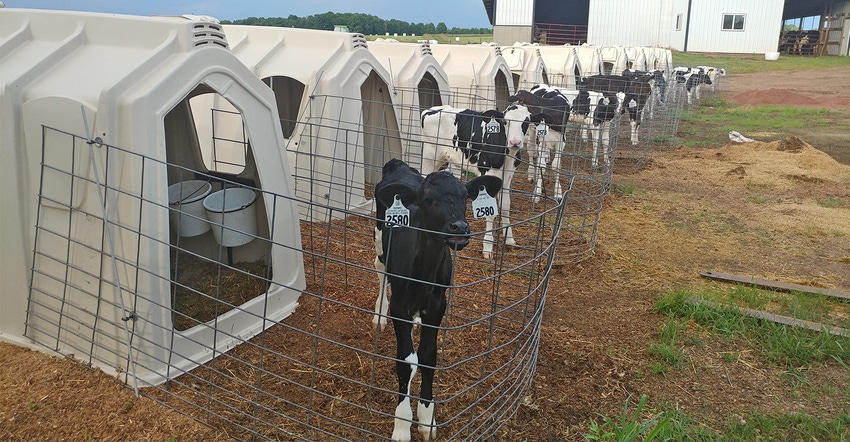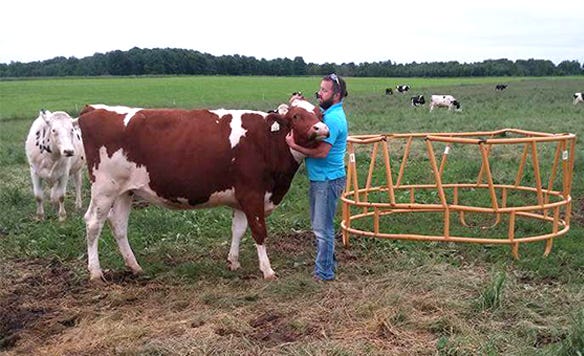
Can you build a highly productive dairy herd with one cow? If you ask Sam Zimmermann, yes, yes you can.
The dairy farmer from Marathon County, Wis., returned to the family dairy farm eight years ago. He, along with his wife, Jenn, started milking 50 cows in April 2010. It was the first time in 15 years that dairy cows returned to the family farm.

DAIRY DUO: “We didn’t inherit the dairy farm,” Jenn Zimmermann says. “We had to buy it. We couldn’t afford 200 high-producing cows, so we had to build own herd using genetics.” Jenn, along with her husband, Sam, operates On-Q Holsteins.

Sam’s father was having health issues. “We decided at that point, at 31 years old, if we were to own the family farm, we needed to do it now,” he recalls. Today they operate On-Q Holsteins LLC.
His parents ingrained in him the value of cattle genetics. Sam knew that buying an expensive genetically superior herd was out of the question for a beginning dairy farmer, but he thought perhaps he could use advances in technology to create it.
Building the herd
Sam was able to buy an unregistered herd and then cherry-pick a bunch of good cows from sales to even out overall cow cost. “So I’d have higher-dollar cows — hardly over $2,000 apiece — from registered sales to mix in with lower-cost cows, to make a $1,400 average herd of cows,” he explains.
But in 2012, one purchase changed the trajectory of the farm.
Sam and his father attended a summer event sale held by Floyd and Lloyd Baumann, twin brothers and well-known Wisconsin dairy farmers. In it was the granddaughter to a cow named Apple — who made headlines in 2008 by selling for $1 million.
“I thought she would go for as much as $10,000,” Sam says. As the gavel dropped and the auctioneer yelled, “Sold,” he won the bid at $4,200. “I looked at Dad and said, ‘This is really going to change our farm.’”
Big plan
He named her Bella. She was a high-type, showy black cow. Since then, she’s been classified by the dairy industry as “excellent,” scoring 92 points. She breeds easily, milks a lot and has a large frame. “I wanted to proliferate that in our herd,” Sam says.
The very first daughter of Bella made it to the 10th spot on the Holstein genomics list. “You saw ‘Sam Zimmermann,'” he says, laughing. “People probably thought, who is that?”
Using technology like sexed semen, in vitro fertilization and embryo transfer, Sam took a single animal — and over five years, between daughters, granddaughters and great-granddaughters — proliferated those genetics to produce a total of 60 cows.
He has even sold a group of Bella’s embryos to China and France.

BIG LUV: Sam Zimmermann is not shy regarding his affection for a few of his favorite cows. “He is in the field, hugging Bella or Luv,” Jenn Zimmermann says. Here he is with Luv.

Returning to roots
Since then, Sam continues to add high-performing females to his herd.
He bought one of his favorites, who he named Luv, as an embryo. After she was born, a friend visited the farm. “He saw the red calf,” Jenn says, “and said there was something special about that calf.” Sam took Luv on the show circuit to the Minnesota State Fair and won it. At the World Dairy Expo, she did not fare so well.
However, Luv’s first daughter via in vitro fertilization, LotsaLuv, finished ninth at the Expo. “It was fun to see her do so well,” Jenn adds.
But it is not all about prize cows. Sam does not pass on nostalgia.
A friend sold the couple a granddaughter of a cow that Sam had shown back in 1997. That cow was part of the original family dairy operation. “There is something about having offspring from your past helping build the future,” he says. Today, with the help of embryo transfer, several offspring of that cow are now in his herd.
“The seed of our old dairy operation was basically replanted in our new operation,” Sam says. “It is amazing what technology makes possible.”
About the Author(s)
You May Also Like






